#minoan woman
Text
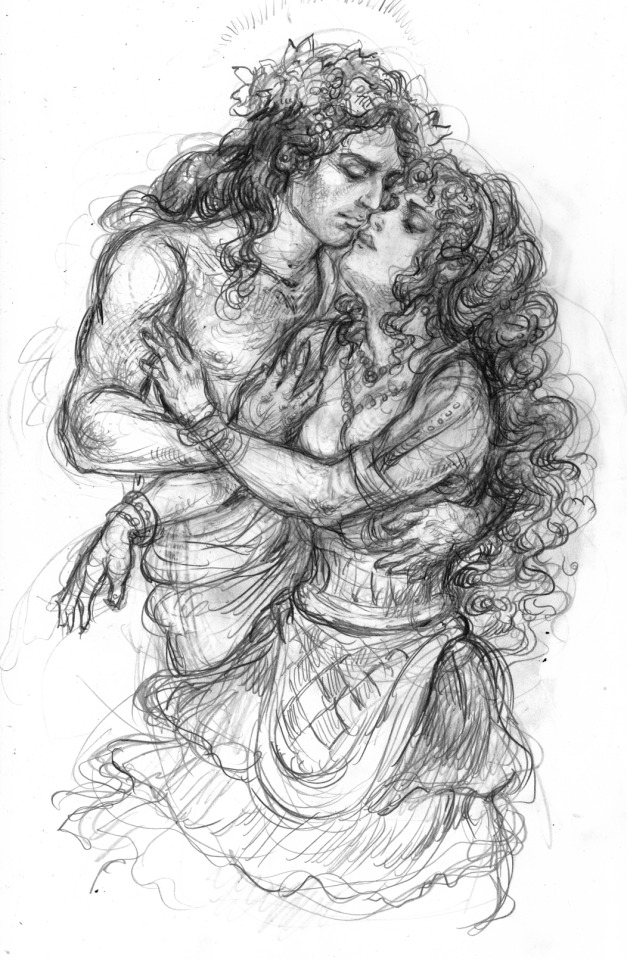
Dionysus and Ariadne for @margaretkart! She's wearing the famous Minoan priestess outfit with belt, apron and flounces, with a pose inspired by classic romance comic artist Nell Brinkley.
#illustration#art#sketchbook#dionysus#ariadne#dionysus x ariadne#greek mythology#greek myths#greek gods#ancient greek mythology#sketch#drawing#romance art#minoan costume#minoan dress#minoan#minoan woman#ancient greece
893 notes
·
View notes
Text
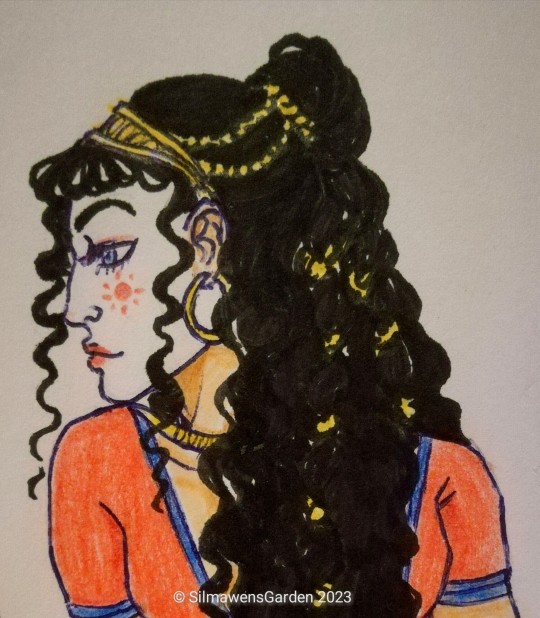
Minoan lady u.u
Seriously quite happy with how her nose came out.
Took some inspiration from frescos and descriptions of feminine beauty. I was actually quite surprised that they used thick white (lead?) Paste to whiten their skin.
41 notes
·
View notes
Text

Minoan Dancer
Dancer in the style of a Minoan fresco.
By Jeff Stanford, 2023
Reworked an earlier image to improve some details and resolution.
Buy prints at:
https://jeff-stanford.pixels.com/
#© Jeff Stanford#midjourney#midjourneyart#ai#discord#digitalart#aiart#Artists on tumblr#portrait#girl#dancer#fresco#woman#minoan
99 notes
·
View notes
Video
youtube
Jordan Chiles Floor Exercise, 2018 U.S. Gymnastics Championships

2 notes
·
View notes
Text

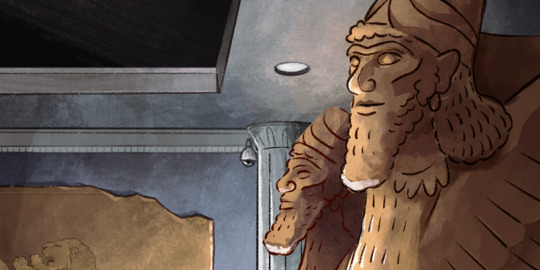
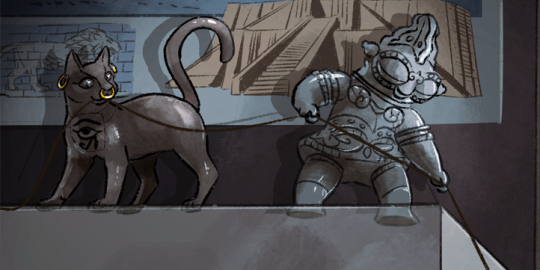


the elevator pitch for this is "a Toy Story/Night at the Museum-style educational series that teaches kids about art history"
they probably wouldn't let me have the tits-out minoan snake woman but that's ok
#illustration#my art#from left to right:#bastet#dogū#minoan snake goddess#colima dog#jizo statue#mesopotamian winged lions#i made the sketch for this back in 2020 and was too afraid to finish it#i dont think it ended up how i wanted it but im glad it ended up somewhere
2K notes
·
View notes
Text
Minoan Heanos
The distinctive open-front dresses worn by Minoan women are probably even more iconic than the multi-layered kilts. Over time, there's dispute whether the garment is one piece or a separate bodice and skirt, but currently the one-piece theory is in ascendance.

The word heanos is derived from the Linear B logogram *146, wehanos. The wes- prefix, which is the squiggle in the middle, indicates a garment. Bernice Jones believes that this logogram represents the garment worn by Minoan men and women.
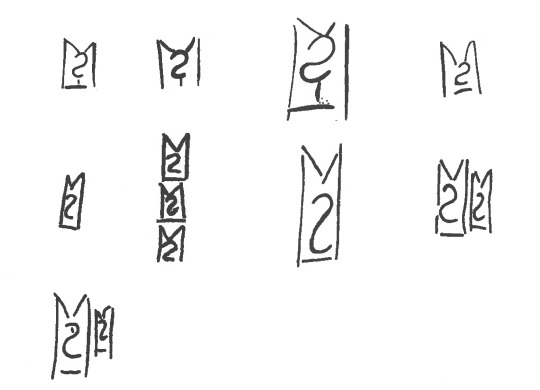
Marie-Louise B. Nosch, The Textile Logograms in the Linear B Tablets, pp 133-138
More research and construction below the cut:
The theory that the garment is a full-length tunic is further supported from imagery from the time, like these figures from the c. 1400 BCE Hagia Triada Sarcophagus. This detail from the sarcophagus shows three figures in some kind of procession, 2 women and 1 man. The woman at left wears a tunic with some kind of pelt as a skirt, and the other 2 figures wear tunics without anything over them, showing that they are one continuous, ankle-length garment.
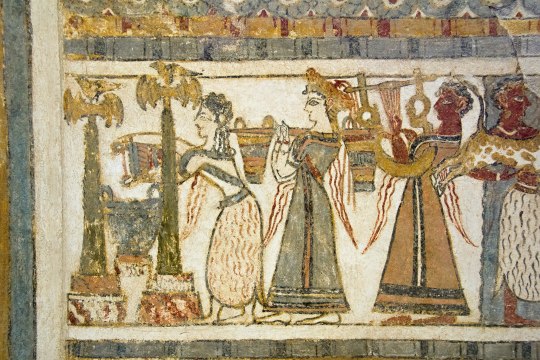
Some of the most important resources for interpreting how the heanos was constructed comes from the two women depicted in the House of the Ladies in Akrotiri, wherein the side seams of the tunic are clearly visible running along the side of the body and under the arm.
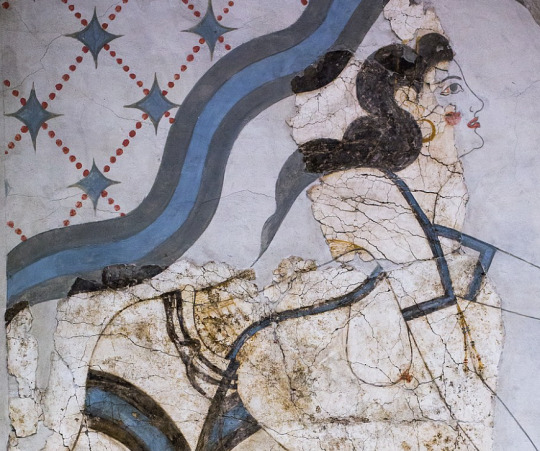
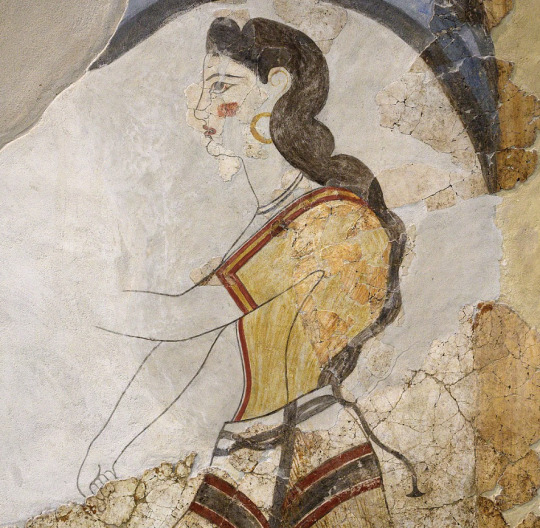
details of figures from the House of the Ladies, Akrotiri, via Wikimedia Commons
advadbsvasb
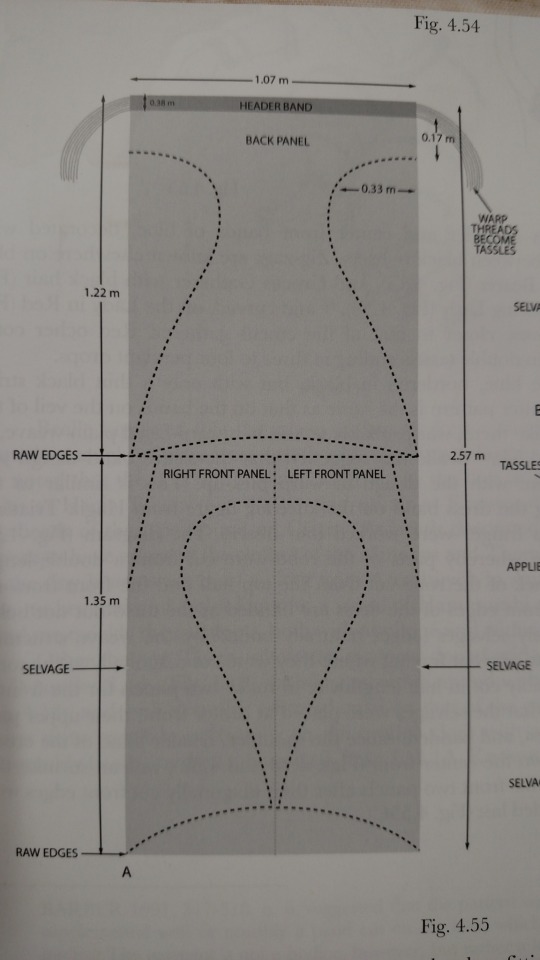

Diagrams from Bernice Jones' book Ariadne's Threads, p. 82, via Gorgeous Tangents
The heanos itself is made of 3 pieces of fabric: 1 back and 2 fronts. These diagrams show a concave hem like on the labrys-shaped kilt but I went with a straight hem, which is an equally valid option. The end of the sleeves are level with the edge of the hem at the widest point. This would probably be the width selvage-to-selvage on the fabric, being narrower than fabric widths commonly are today. There are 4 seams: the shoulder seam, the two side seams, and a front seam (optional, but recommended if you would prefer not being arrested.) It may be tempting to fold the fabric across the shoulder, so the only sewing is side seams and a neck hole, but this makes a weaker garment overall. I used this as a shortcut in my fitting muslin and it caused tears and weak points at the three points of the front opening.

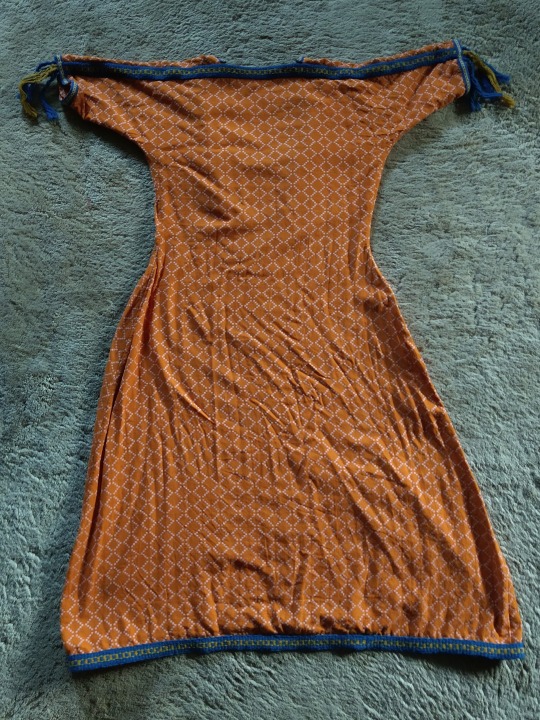
my fabric was a lightweight, moderately loose-woven cotton with a supplementary weave pattern in squares and diamonds. Linen or wool would have been more accurate but also? much harder to find from online quilting stores selling fabric for affordable prices. The main fabric is dark orange and the pattern is made out of pink/lilac threads. This weaving technique resulted in a LOT of long floats (unsecured expenses of thread) on the back--you can see how the wrong side of the fabric is much pinker than the right side. These floats could snag easily if I wasn't careful, so while it made a very effective visual for this tunic, I do not think that this fabric type would be viable for everyday wear. I'll leave it to people who actually know about weaving to ponder what more accurate weaving techniques would be.
Construction
The overall pattern is basically a T-shaped tunic, and the most important measurements are shoulder circumference, shoulder width, bust circumference, and the shoulder-waist length. In addition, you need measurements for the bicep, waist, shoulder-navel length, and hip circumference. After working out the fit with a muslin, I ended up with this pattern, 1 of 4 identical quarters.

Your first impulse may be to make the tunic very close-fitting, since the depictions in frescoes are skin-tight, but since the pattern has no added gusset this is a recipe for Cannot Move Arm. So I gave a very generous curve under the arm, which also made the dress look better when my arms were down, avoiding armpit wrinkles. I continued that ease into about an extra 2 inches added on to my waist measurement and plenty of extra space around my hips so that I could do exciting things like Sit Down.


I sewed the shoulder and side seams using the machine, and felled the raw edges on each side of the seam by hand with a whipstitch. I foided back the front edges of the v-neck instead of cutting them, which was a tip I got from the Gorgeous Tangents blog. This strengthens the neckline and keeps it from stretching, and also means that everything can be readjusted if you have size fluctuations or just want to modify the tunic into something more or less modest.
I whipstitched the front edges together by hand--the contrasting selvage didn't matter because it would be covered up by trim. I ended up cutting the tunic a liiiittle shorter than I wanted, so I finished it with some leftover bias binding instead of hemming it to conserve as much length as possible.
Trim

I custom-ordered the woven tape trim from Long Creek Mercantile. Both are made of wool--the "header band" and the hem trim are 1 1/4" wide and the center-front and cuff trim are 3/8" wide. I observed that most images of the Minoan heanos show trim with two colors at most, in a simple geometric or linear pattern, so I consciously restrained myself from ordering anything more elaborate. The clothing on Minoan frescoes is characterized by strongly contrasting colors, so blue trim was the most obvious, and best-looking option. Orange tunics with blue trim appear multiple time in art like the "Dancing Lady" fresco from Knossos:

Dr. Jones suggests that the band across the shoulder would historically have been a header band--a band of threads woven at the beginning of a project in order to properly space the warp bands (see her diagram at the beginning). That may be a reason why the shoulder trim often depicted under the front or sleeve trim, as shown above. Regardless, the trim almost always coordinates.
I sewed on the shoulder trim by hand, the sleeve and hem trim by machine, and the center-front trim with a combination of both.
Tassels
Many frescoes from Akrotiri and Hagia Triada show the ends of the supposed header band turned into tassels. This embellishment is not universal among heanoi, as you can see from the "Dancing Lady" above, but it does add a fun little something!

(yes, my Lounging Pants are very fashionable)
I turned the excess ends of the shoulder "header band" trim into fringes, knotting the yellow ones into a lattice and turning the blue yarns into tassels. The lattice-tassel appears on a fresco from Hagia Triada:

Reproduction of fragmentary fresco from Room 14 at Hagia Triada, Crete
The saffron gatherers from Akrotiri shown below have clearly displayed fringes at the ends of their sleeves. The one on the left has red fringes that appear knotted or ravelled/unravelled in an undulating pattern, and the one on the right has fringes that may be either beaded with papyrus-shaped leaves or cut into short tassels.
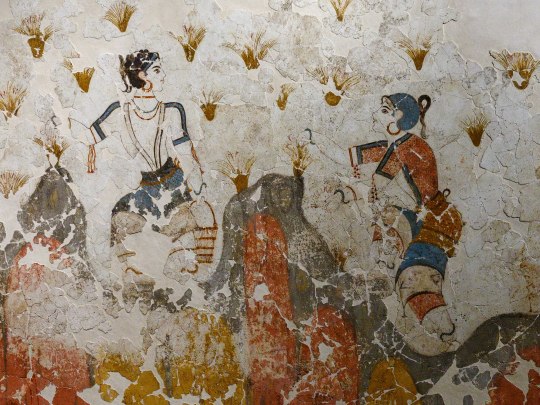
Another option is leaving the fringes loose, as seen in the Akrotiri frescoes from Xeste, room 3:
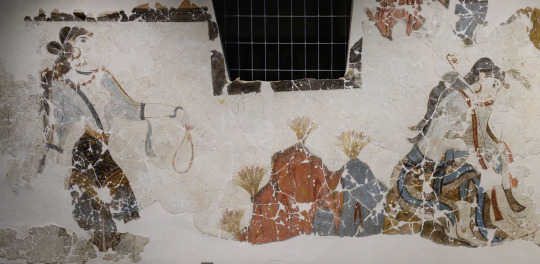
The final garment was super comfy, actually! It's much simpler to create than I thought it would be based on the frescoes, which made it all feel pretty magical when everything came together. I did think it was a little unusual how tailored this garment is, and the potential waste of fabric that comes from a shaped garment, especially compared to how later ancient greek clothing was mainly rectangles. I don't know enough about bronze-age and earlier clothing to have any idea how typical this was, since I'm extremely Not an expert on this subject, but am always open to learning more!
477 notes
·
View notes
Text
every now and then i think about this article that i read which traced the origins of Dionysos back through the ages. and apparently, He's one of the oldest deities known from the Greeks, and His name was seen on Linear B tablets dating back to the Minoans.
this is interesting for two reasons:
Dionysos is so often seen as a "foreign God", who came roaring out of some mysterious mountain in the East. but He's also there with the Minoans, receiving pretty large sacrifices, almost 3500 years ago.
the Minoans were the civilization that Ariadne came from - they were named after King Minos, they were actively on Crete. i can only wonder how old the story of Ariadne and Dionysos is, then. Ariadne wasn't mentioned in the article, but some research shows that it's a not unheard of opinion that Her name is old, and there's a good chance it came from the Minoans.
these two things put together just kind of show how interesting Dionysos is when it comes to being a God of opposites. He's been worshiped in Greece for almost 3500 years, and yet He's a young foreign God. He's married to a mortal woman and yet Her name echoes back to the very birth of Her own mythic kingdom, with an origin that may mean "most holy". together, Dionysos and Ariadne are both eternally young and eternally old, and there's just something that sticks in my head about that, you feel?
anyways, here are the two articles that i used for this:
Ariadne - Wikipedia
The Shocking True Origins of Dionysos - by Spencer McDaniel
#anyways there's something inherently sexy about ancient undeciphered languages like Linear B and all the things they're hiding <3#dionysos#dionysian#dionysus#dionysos deity#dionysus deity#ariadne#ariadne deity
307 notes
·
View notes
Text
Okay, actually, let me do a quick, basic primer for Mycenaean fashion, if anyone would want to try this aesthetic for their Greek myth art since Mycenaean era Greece (1400-1200 is when the majority of the myths happen, and especially the Trojan war). Not claiming to be an expert at all, here, as I've mostly googled shit and screencapped images to use as ref and then read some articles, but, I figure, it might be somewhere to start!
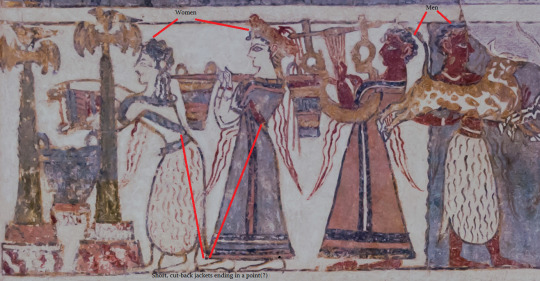
Here's one of the panels from the Hagia triada sarcophagus, from Crete during Mycenaean control/hegemony of the island. The women are painted white, the men dark; artistic aesthetic you see in other cultures for their visual arts of the time, like Ancient Egypt.
I think the fur(?) skirts might be religious wear, but aside from that, you have one woman and one man (specifically, the lyre player, which is probably indicative of some cultural attitudes; the lyre player in the fresco from Pylos is definitely wearing a fringed skirt of some sort, similar to what women wear) wearing a long robe/tunic, and the women are wearing some short jackets on top of that.
The jackets might be Cretan or merely "early" style, because here's a fresco fragment from the Greek mainland where the woman appears to wear something similar:
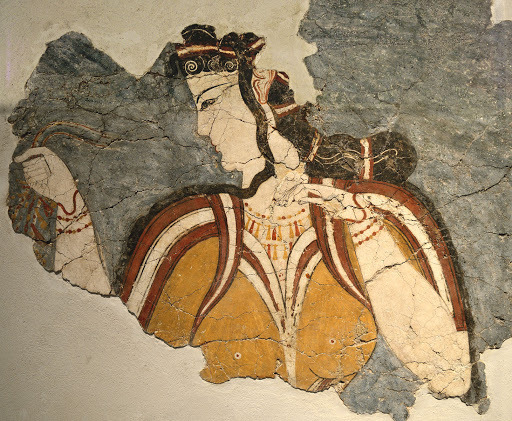
It's probable (but basically impossible to know) that the thing underneath is a long robe/tunic like the women above are wearing, short or sleeve-less.
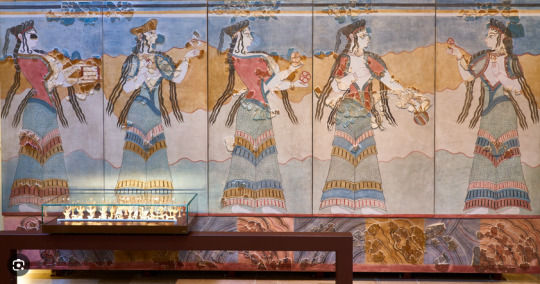
Another Mycenaean/mainland Greek fresco. In this one you'd have to decide if the top halves of the women's dress is a short (but not cut-away) jacket, plus wrap-around, tiered/fringed skirt, or a long robe/tunic with really deep neckline and, again, a wrap-around tiered/fringed skirt.
Now, you don't need to make things harder for yourself than you have to! Women can wear a simpler style of dress (like what the man in the first fresco panel is wearing), basically the same as the men's, probably just longer:
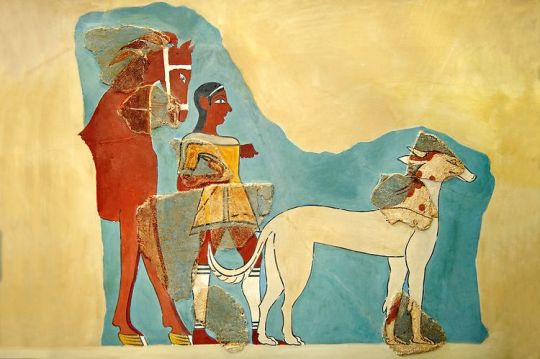
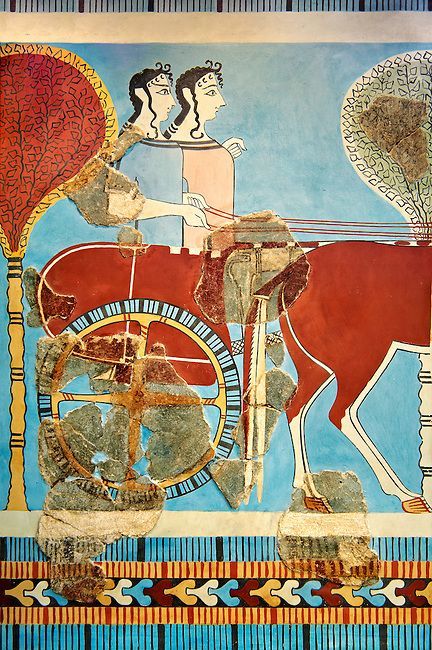
It's possible these two women are wearing wrap around skirts below the edge of the chariot, but I doubt it. As you can see, their style of dress is the same as the man's above, with a plain, straight collar.
The various lines you see plunging down the sides of both the longer robes/tunics and the shorter ones are down the sides (under the arms and down) and might also/either be down the front, at least on the long dresses with elaborate bottom rim; the woman in saffron above clearly has a decorated line going down her front.
I'll put the rest of this under the cut!

Some nice art with Mycenaean-era dress and armour for some of our Trojan war characters. (Aeneas and Hektor notably wearing Mycenaean wear even if they probably wouldn't be.)
I like this site http://www.salimbeti.com/micenei/index.htm for both art and a lot of pictures of artifacts when it comes to armour and weapons from the Mycenaean era.
The men don't just wear those tunics, though; you can get some (short) kilts or skirts;
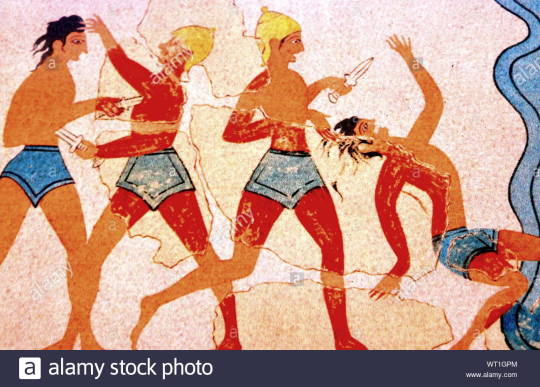
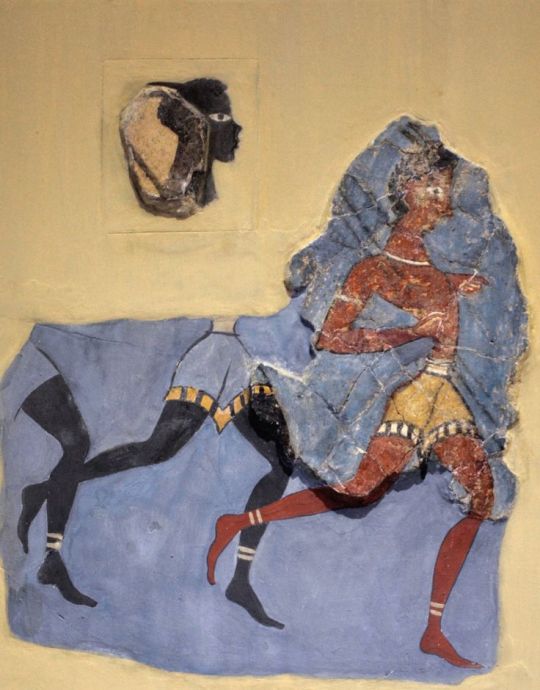
(In my opinion, I'd say it's basically a given the one/two dudes painted in basically black are meant to be from further south compared to the Greek dude here. Probably not sub-Saharan Africa, however. North Africa/Egyptian might be more reasonable, despite the impossibly dark skin.)
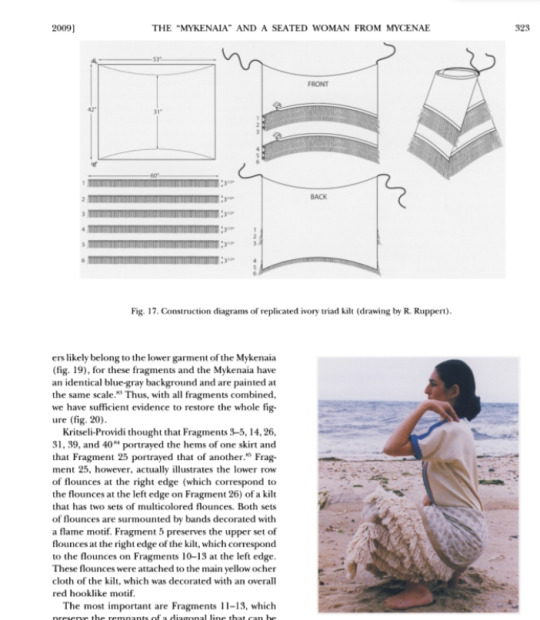

Some examples of the clothes recreated!
This article https://www.jstor.org/stable/20627591 talks about a fresco and its possible reconstructions, and, more importantly, includes photos of some women's clothes, especially the fringed/tiered wrap-around skirts recreated, and some drawing diagrams of said skirts that might be helpful!
Hair-wise, the majority of the men have hair anywhere from around the ears down to the shoulders in mainland Greece. (The exception being, again, the Pylian lyre player.)
Minoans, even mycenaean-era Minoans, might have longer hair; one of the panels on the Hagia triada fresco has a flute-player with hair down to his waist in braids (or something like that), for example.
All the women, no matter Cretan/Minoan or Mycenaean/Greek have very long hair, gathered in variously more or less elaborate hairstyles; make your best guess from looking at the frescos is my suggestion!
#greek mythology#trojan war#I might add a reblog for jewellery?#but trust me you can find lots of nice pictures of#mycenaean jewellery if you search exactly for that
372 notes
·
View notes
Text

Unknown, Figures, Crete: First Palace Period
The Classical World, Pre-Hellenic Era, Crete, First Palace Period, Middle Minoan Ib, II
Man and woman votaries; man wearing cod-piece cloth and belt drawn tight to accentuate the slim waist, triangular dagger hanging from belt; hands raised before chest, elbows out; woman wearing bell-shaped skirt, high elevated collar, large developed "breton" on head. Pendelbury describes such figures as follows: The flesh of the women is painted dull white and that of the men red or dark brown after the Egyptian convention. It is possible that the thick padded cod-piece was necessary as a kind of primitive truss, for violent effort with an artificially constricted waist is very productive of rupture. He speaks of the fact that in Eastern Crete the use of the early triangular shape ought to have died out by the time of these figurines and fails to consider the possibility that this may be an illustration of the persistence of older forms in ritual use long after they have been abandoned for more evolved forms in daily use.
113 notes
·
View notes
Text
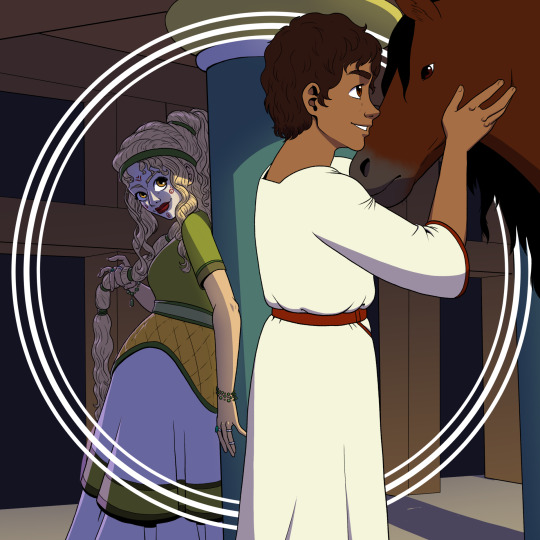
Classicstober Day 18: Phaedra (𐀙𐀂𐀉𐀨)
Phaedra was Ariadne's sister and married Theseus to become Queen of Athens (that must have been a WILD Christmas dinner). Things were good until Theseus' son by the Amazon queen dropped by for a visit. His name was Hippolytus (𐀂𐀢𐀬𐀵)…
Phaedra's story isn't quite as well known as many others in greek mythology, outside of a few tragedies and operas. The nature of the beast for most of these stories is that there are a couple of versions and no one can say which one is the 'real' one, but Phaedra's story, depending on the version you go by, can have wildly different vibes.
As I mentioned, she was Ariadne's sister. In some versions, when Ariadne helped Theseus defeat the Minotaur and escape, Phaedra was with her and part of Theseus' crew when he decided to abandon Ariadne on Naxos, eventually becoming his wife in Athens. In others, Phaedra is ignorant of the role Ariadne played in Theseus' victory and is instead sent to Athens to marry him for a political alliance. The implications of both versions are fascinating from a story-telling perspective. If Phaedra left with Theseus, just how complicit was she in leaving Ariadne behind? If their marriage was purely political, what did she think of the man who had just abandoned her sister? In the end, though, the important part (story wise) is that she marries Theseus and becomes Queen of Athens.
I depicted Phaedra here in her full queenly raiment. Yes, Athens was a purely Mycenaean settlement at this time, but the Mycenaean woman's fashion borrowed LOTS from the Minoan and considering where Phaedra was born she deserved a more Minoan look. That's why she has that quilted-looking over-garment on her dress. I made her palette green to represent her role as queen of Athens, and since Athena is the goddess of olive trees it made sense to me to lean into it. She is also blonde and amber-eyed to show her connection to Helios through her mother, Pasiphaë.
The architecture here is based on Minoan buildings. I imagine that inside the Cyclopean walls of Mycenaean Athens they could afford to make things more royal and less military-pragmatism. Athens is known for being a center of intellectualism in the ancient world (an image they painted themselves with), but even though this scene is set many centuries before the height of Classical Athens' power I decided to lean into that here too.
As for Hippolytus… the sources we have for the ancient Amazons are vanishingly rare. Most scholarship has focused on the Phrygians during the Classical Period, and I was able to find precious little reference for the Bronze Age Phrygians that might represent the historical Amazons. I did find one reconstructed garment, and even though it was very plain (and probably mean for a woman) I decided to put Hippolytus in it anyway. The Amazons were practical warriors, so I doubt that, as a child, Hippolytus would have had any other clothes than what his mother had. I also decided that he should be tall, taller than Theseus, as the Amazons were said to stand taller than normal men.
I could go into more details on the very disastrous story between Hippolytus, Phaedra, and Theseus, but I think it falls outside the purview of this piece. It is a fascinating, compelling story, though, so if you have made it this far into my ramble then I recommend checking it out.
#classicstober#classicstober23#classicstober2023#phaedra#hippolytus#greek mythology#ancient greek mythology#greek myth art#mycenaean#linear b#tagamemnon#amazons
154 notes
·
View notes
Photo

Minoan Pilgrim Dress
Based off a clay statuette of a Minoan woman in a state of worship from Piskokefalo.
Long dress category
11 swatches
Base game compatible
Feminine
DRESS DOWNLOAD - Dropbox (no ads)
#my cc#my cas cc#s4cc#ts4cc#sims 4#sims 4 cc#ts4mm#ts4 dress#minoan#crete#cretan#greek#greece#bronze age#ts4 history#ts4 history cc#ts4 historic#ts4 historic cc
221 notes
·
View notes
Note
Could I please get some fun facts about the glorious country of Greece?
Greece, or "Hellen" as her friends call her, is the country where mythology and pillars come from. Every child across the world is taught that pillars can be Doric, Ionic, or Cornthian, but not why this matters. They are also taught that Greece exists, but few learn why this is important either.
Greece includes many fictional islands such as Chryse, Phraxos, and Aeolia. It also has real islands such as Crete, where the Minoans once lived, Minoa, where some cretins once lived, and Lesbos, where Sappho lived. Sappho is regarded by historians as the first woman to have female friends, because many historians do not know what gay people are. Greece is known outside of such circles for having many gay people, being the second most popular LGBT dwelling place after only Tumblr itself.
Greece is known as the "Birthplace of Democracy" because it achieved the state in the early 1970s with something called a "Metapolitefsi," which is unrelated to the Dr. Seuss concept of the same name. The Metapolitefsi was needed after a right-wing military junta took over the country, much like in the United States in 2025.
120 notes
·
View notes
Text

6: The Snake-witch
The so called "Snake-witch" is depicted on a picture stone on the island of Gotland, dated to 400-600 CE. We don't know who the figure is supposed to be, one theory even suggests that it is an imitation of Continental motifs of Daniel in the lions' den, others have seen it as some kind of witch or völva. That the woman appears to be naked also brings the mind to the sexual themes in seiðr (a kind of Old Norse sorcery mainly practiced by women). I thought it would be fun to draw her as a Scandinavian equivalent to the Minoan "Snake Goddess".
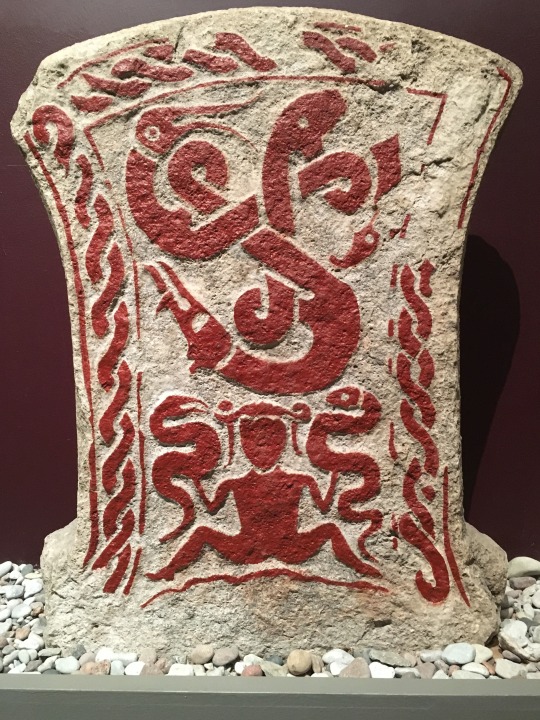
83 notes
·
View notes
Text
The myth of Dionysos (4)
The Dictionary of literary myths does not have just one article about Dionysos… But two! And since I translated the first, let’s journey through the second: it is titled “Dionysos: The evolution of the literary myth”, and it was written by Ann-Déborah Lévy-Bertherat.
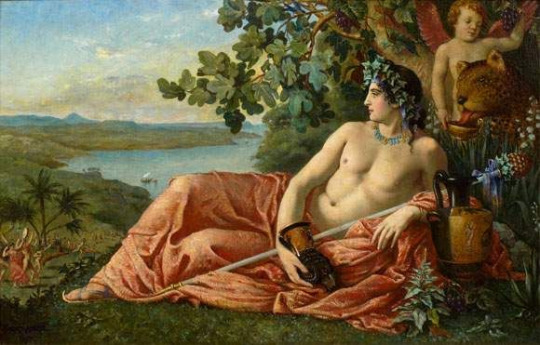
According to the imagery of the Ancient Greeks, Dionysos is supposed to be a young god – he is often depicted as a teenager, sometimes even as a child. This perhaps explains why his Greek name was thought to be the counterpart of the Phrygian “Dioskouros”, “the boy of Zeus”. However, it seems more plausible to link Dionysos’ name to Nysa, both nurse and homeland of the god. But no matter which of these explanations is right: both highlight and insist on a foreign origin for the god. A foreign origin that we know to be purely mythical rather than historical – indeed, the Mycenaean texts proved that the cult of Dionysos was implanted in Greece since a very, very old time, and was not a “recent importation” as classical Greeks believed.
But then, why make Dionysos a “foreign god”? Maybe because, in a symbolic way, it is important for Dionysos to be a god that “comes and goes”, a “god that arrived” – or maybe, it was a much needed element to explain his strange, bizarre and frightening character.
I/ Births and rebirths of Dionysos
Semele, a mortal woman loved by Zeus, died because of Hera’s jealousy: she asked her divine lover to appear before her in all of his glory, but this resulted in her death struck by his lightning. Removing the child she was bearing in her womb, Zeus placed the unborn into his own thigh, where the baby completed his growth. As such, Dionysos knew a double-birth, and his cult was deeply marked by this. One of the Dionysiac rites is the ritual of the liknites (child in crib) – where a child has to disappear and be searched by women in vain, for he will only reappear one year later.

The Passion of Dionysos: The myths of Dionysos’ childhoods and wanderings depict him as a persecuted god. One time he is dismembered, boiled and devoured by the Titans before being resurrected by Demeter. Another time Hera curses with madness Semele’s sister, Ino, first nurse of the god. In a third tale pirates kidnap the child to sell him as a slave. Homer, in the Iliad, retells of how Lycurgus, armed with an axe and a desire to kill, hunted down Dionysos and his nymph-nurses – the child had to throw himself into the sea, where he was saved by Thetis. The true “passion” of Dionysos (in the Christian meaning of the term) always suffering, always dying, but always resurrecting, seems to be a symbol of the vegetal cycle. As a result, it is no coincidence that the four great holidays of Dionysos are all placed between the end of December and the beginning of April – aka, between the winter solstice and the arrival of spring.
Ivy and vine: Legends insist on the ties between Dionysos and other vegetal deities, such as Cybele or Rhea – two incarnations of the great Earth-mother, two deities that shield Dionysos from Hera’s revenge. There are the agrarian nymphs that constantly surround the god; there is his lover, Ariadne, that was originally a Minoan goddess of vegetation; and there is of course Demeter, to which he is tied through the Mysteries of Eleusis (and Pindar even goes as far as making Dionysos and Demeter a couple). Dionysos is also called Bacchus (a named which, according to Euripides, comes from “bacchos”, the “branch” the “bough”) ; he is said to be a “ploutodotes”, a “wealth-giver” ; he was believed to give strength to plants and to help them grow ; and among his numerous attributes, his most prominent ones are the ivy (of which he is crowned) and the grapevine (which he offered to the world). These two plants have always a savior role in his myths. It was said that the child Semele bore was protected from the lightning by ivy ; the pirates were frightened when ivy and vine started growing around their ship’s mast ; a nymph hunted by Lycurgus turned herself into vine to choke the murderous king… And yet, these two plants are such a contrast they can only make the god ambiguous: ivy is coldness and sterility, where the grapevine is warmth and generosity. Dionysos is almost most famed as the god of wine: it is the wine that symbolizes the presence of the gods during festivals; during the Lenaia festival (January-February) the new wine is offered to the god (symbolized as a bough-decorated mask). Dionysos “polygethes” (joyful, happy) is said, according to Euripides, to have the power to “laugh and put to sleep all our problems”.
Fertility and fecundity: This god, friend of the nymphs, who found a home with Thetis at the bottom of the sea, whose statue is ritually plunged in water at Halai, who was said to have entered Athens on a naval chariot, has too many affinities with water and humidity (an universal symbol of fertility) for his power to limit itself just to plants. Indeed, let us take a look at his cohorts and parades: w find in there donkeys, goats and bulls, usually painted in an ithyphallic position; and he is surrounded by Satyrs and Silenes whose lubricity and lust are meant to parallel the chastity of the Maenads. Dionysos himself, during the Anthesteria festival (February-march) knows a physical and sexual union with the Basilinna, and by doing so ensures one year of fecundity for all of Athens. The exaltation of fertility in Dionysos’ cult is most expressed through phallophoria – but the particularity of Dionysos is that he depicts a complete and “full” fecundity, with both its masculine and feminine attributes. Dionysos, in his myth like in his cult, is surrounded by women: Aeschylus calls him “effeminate”, explaining his youthfulness (he hasn’t grown a beard or body hair yet), and his clothes (he usually wore the women’s peplum). Some even depict him as an androgynous figure, and the ambiguity of his sex reminds the one of the hermaphrodite and their “ideal fecundity”. The French poet Baudelaire will even interpret the thyrsus, a long, leafed staff held by the followers of the god, as the union of the masculine symbol (the straight staff) and the feminine one (the curvy boughs wrapped around it). Dionysos is “polygethes” and “ploutodotes” – but reducing Dionysos to this sole role would be removing from him his “dark side”, the eviler part of his power. For Homer calls him “mainomenos”, the “demented one”. He is a god that disturbs, he is a god that break the order.
More about this next time, in “The Frenzied God”!
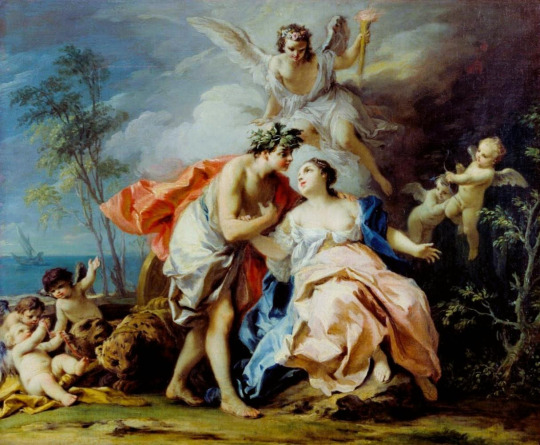
48 notes
·
View notes
Video
youtube

6 notes
·
View notes
Text

"Minoan Goddess", 2023. Gouache and ink on paper.
This illustration draws inspiration from the ancient Minoan femininity with a futuristic point of view. Is she Ariadne, the Lady of the Labyrinth, a goddess turned heroine, or a Minoan woman celebrating both her sensuality and dynamism? I can only wonder myself.
#art#symbolism#mysticism#mythology#spirituality#divine feminine#minoan goddess#ariadne#illustration#original artwork#gouache#vera bousiou#artwork#dreamy#mystical#artists on tumblr
31 notes
·
View notes